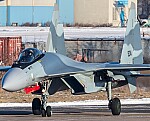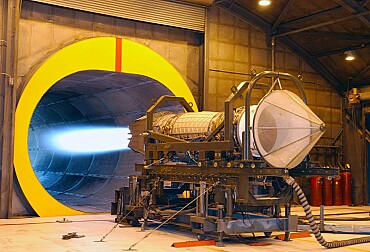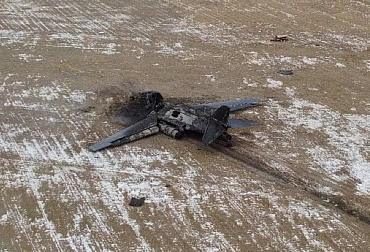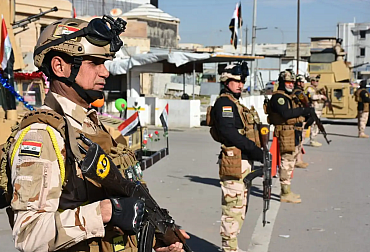The French Rafale M Jet is the only non-US jet cleared to operate from the US carriers
Dassault Aviation's Rafale is a multi-role fighter aircraft developed for the French Navy and Air Force. It entered service with the Navy in 2002. In addition to France, it is used by the Egyptian, Qatari, Indian and Greek Air Forces. Croatia is currently taking first deliveries, Indonesia and the United Arab Emirates have also placed orders, while India strenghtens its numbers with 26 Rafales Marine.
The Rafale, which joined the French Air Force in 2006, which is now equipped with the new F3-R standard version, representing a genuine revolution. A benchmark fighter at the cutting edge of technology, this latest-generation omnirole fighter with optimised survivability carries out the following missions, among others: air defence and superiority, deep strikes, attacks at sea and on the ground, bombing, tactical reconnaissance and intelligence, and nuclear deterrence.

Thanks to the F1 and F2 standards, the Rafale was already a formidable weapons system, with enhanced air-to-air capability, L16 tactical data link and the ability to carry SCALP cruise missiles. The latest F3R standard integrated into the Rafale, developed in 2018, offers a host of improvements and new capabilities to this flagship fighter.
It mainly enables the implementation of a number of innovative instruments: the long-range air-to-air missile, the latest Meteor missile giving it a long-range target engagement capability that is unique in the world, the intelligent detection pod, the Talios designation pod, and finally the laser terminal-guided version of the modular air-to-ground weapon, adapted to moving targets. The most significant development enabled by the F3-R standard relates to the safety and protection of the aircraft and its crew with the Automatic Ground Collision Avoidance System (AGCAS), a first for the French Air Force. Since 2012, it has been the first European fighter aircraft to be equipped with an active electronically scanned radar.
The French Air Force operates 102 Rafales with 7 Squadrons (1/4, 2/4, 2/30, 3/30 and 1/7, and the fighter and transformation squadron 3/4, and the experimentation figher squadron 1/30) from three major air bases. The 46 M (Marine, Navy) aircraft, the only non-US fighter type cleared to operate from the decks of US carriers, serve with 3 "Flotilles“ (11F, 12F, 17F) from the Naval Air Base Landivisiau.
Rafale in Croatia – pilots trained by the French Air Force
In November 2021, Croatia confirmed its intention to purchase 12 used Rafale F3R fighter-bombers, including two two-seaters, from France, signing the order worth a total of just over one billion euros including VAT, with the aim to replace the outdated MiG-21Bis/UM.
Croatian Defence Minister Mario Banožić said the major aim was to acquire a powerful deterrent for the next "thirty or forty years" in order to "considerably strengthen its international position and the protection of its airspace", while moving closer to NATO standards. The delivery of the first Rafale was eagerly awaited.
That delivery took place on 2nd October at the Mont-de-Marsan Air Base. A Rafale B, number 170, was officially handed over to the Croatian Air Force at a ceremony attended by Mr Mario Banožić, Zvonimir Frka-Petešić, the Croatian Prime Minister's Chief of Staff, and General Luc de Rancourt, the second-in-command of the French Armed Forces General Staff.
"The power projection capability we are gaining with the Rafale will profoundly change Croatia's strategy and positioning on the geopolitical and military map of Europe. This will enable us to make a further contribution to strengthening security in our part of Europe, where the Rafale's air superiority will be unprecedented," Mr Frka-Petešić said.
The Croatian pilots were trained by the French Air Force, specifically the Rafale Transformation Squadron 3/4 "Aquitaine", based at Saint-Dizier Air Base 113. The first six Croatian Rafales, including the No. 170, will be assigned, from early 2024, to the 191st Fighter Squadron, based at the Pleso Base, near Zagreb. According to the Croatian Ministry of Defence, the necessary infrastructure is still being developed at the base.
At the same time, Croatian technicians and pilots are undergoing complementary training provided by the Conversion Training Centre set up by Dassault Aviation at Mérignac. In addition to the 12 Rafale F3Rs, the Croatian air force is also to receive a flight simulator, ground equipment and spare parts.
Navy Rafales in India – the ability to carry nuclear warheads
And Croatia is not the only new user of the Rafale jets. The Indian Government has given the go-ahead for the purchase from France of 26 aircraft it’s Navy. This purchase, announced in July, follows the acquisition of 36 aircraft seven years ago for the Air Force. It's another success for French manufacturer Dassault, given the competition from the American F-18 fighter.
The reasons for the Indian choice are rather obvious. The first one is purely practical: the Indian Air Force already has Rafales, which have been adapted with specific communication systems, and the Navy can easily and at no extraordinary costs benefit from this investment. The supply of spare parts and missiles will also be shared between both branches, which reduces long-term costs.
The truth is that the Rafale Marine cannot fold its wings, unlike the American F-18 Super Hornet, which makes it less practical on an aircraft carrier. But the French aircraft has other advantages: France has agreed to allow Indian Rafales to carry nuclear warheads, which the United States refuses to do. And the French aircraft and its missiles have a much greater range than the F-18 (1500 km vs 600 km), which is essential for India, which faces its powerful Chinese adversary.
More than 330 Rafales in service and ordered
With Croatia and India, the total number of Rafale’s users reaches 5 coutries. Besides France which operates about 150 Rafales with it’s Air Forces and Navy, there will soon be more than 50 Rafales serving in Egypt (24 were delivered between 2015 and 2019), 36 in Qatar (ordered in 2015 and 2018), 36 in India (Air Forces, already delivered), 24 ordered for the Navy, and 24 will serve in Greece (by summer 2023 15 Rafales were already delivered). Indonesia and United Arab Emirates will join the club shortly with 42 and 80 Rafales on order respectively.
Specifications:
Length: 15.27 m
Wingspan: 10.90 m
Height: 5.34 m
Empty weight: 10,300 kg
Max takeoff weight: 24,500 kg
Powerplant: 2 × Snecma M88-4e turbofans, 50.04 kN each, 75 kN with afterburner
Maximum speed: 1,912 km/h, Mach 1.8
Combat range: 1,850 km
Ferry range: 3,700 km
Service ceiling: 15,835 m
Guns: 1× 30 mm GIAT 30/M791 autocannon, 125 rounds
Hardpoints: 14 External hardpoints for Air Force versions, 13 for Navy version










